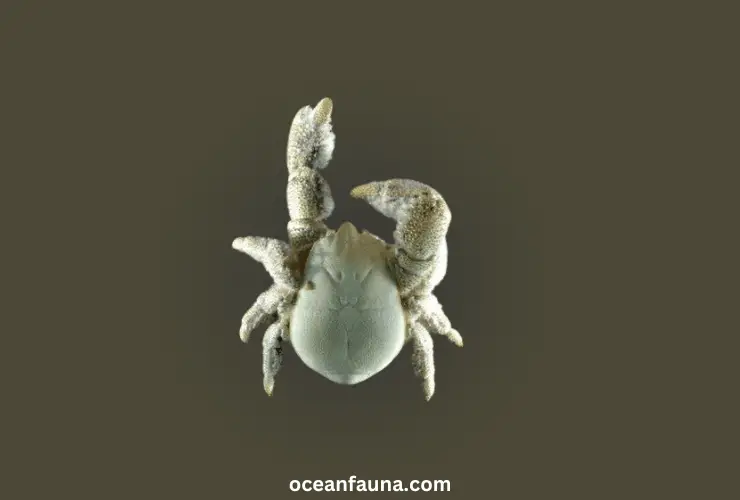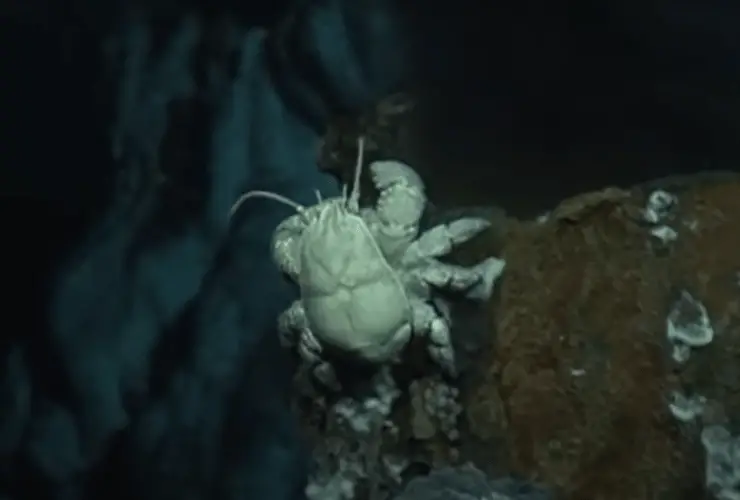The Hoff Crab, also known as Kiwa tyleri, is a mysterious creature first discovered in 2010. It lives in the deep-sea hydrothermal vents of the South Pacific Ocean. It can grow quite large, up to 15 cm in body length, and weigh between 2-5 pounds. Its unique appearance and behavior have made it a fascinating subject for marine biologists and ocean lovers.
What sets it apart is its hairy pincers, which look like the famous Hoff character from the TV show “Baywatch,” hence its common name. These pincers help it capture prey and defend against predators in the extreme environment of the hydrothermal vent.
Scientists have found that this crab split from its hairier-clawed Kiwa cousins over 26 million years ago. They then spread to different oceans to find suitable environments.
If you want to learn more about the Hoff Crab’s taxonomy, distribution, feeding habits, and importance in marine biology, read on! There are some exciting facts to discover.

About Hoff Crab – A Quick Biology
Let’s take a quick glance at this fascinating species of hydrothermal vents.
| Parameters | Details |
| Scientific name | Kiwa tyleri |
| Kingdom | Animalia |
| Family | Kiwaidae |
| Phylum | Arthropoda |
| Subphylum | Crustacea |
| Genus | Kiwa |
| Class | Malacostraca |
| Order | Decapoda |
| Species | K. tyleri |
| Habitat | Deep-sea |
| Color | Pale white, grey, and yellow |
| Diet | Bacteria |
| Geography | South Pacific Ocean |
| Weight | 2 – 5 pounds |
| Length | 15 cm (6 inches) |
| Lifespan | 10 – 20 years |
Taxonomy and Classification of Hoff Crab
The Hoff Crab is a member of the family Kiwaidae, a group of deep-sea crabs found exclusively at hydrothermal vents. A team of scientists from the British Antarctic Survey discovered it first in 2010 while exploring the East Scotia Ridge.
The Hoff crab is not classified as a “true crab,” but belongs to a closely related group called squat lobsters. This group also includes hermit crabs. It belongs to the order Decapoda and class Malacostraca.
Did you know? The species was given its scientific name after Professor Paul Tyler. He’s a renowned deep-sea biologist who has significantly contributed to our understanding of the ecology of hydrothermal vents.
Geographical Distribution and Habitat – Where Do Hoff Crabs Live?
The Hoff Crab is a deep-sea creature that lives in a harsh environment with high pressure, low temperature, and complete darkness, as reported in a PLOS ONE publication.
Even though it’s a harsh environment, hydrothermal vents are a home for many species that have learned to adapt to these challenging conditions. The Hoff Crab is found exclusively in the Southern Ocean, specifically in the East Scotia Ridge, at depths of up to 8,500 feet.
Anatomy and Physical Characteristics – What Does Hoff Crab Look Like?
Hairy Body
Hoff crabs have compact, oval-shaped bodies covered in long, hair-like setae, which gives them a fuzzy appearance. Their pincers are wrapped in these setae as well. The hairs on their pincers allow them to collect bacteria from the water and feed on it.
Size
In terms of size, Hoff crabs can grow up to 15 cm in length, with an average weight of 2-5 pounds, although they are typically smaller.
Exoskeleton
Hoff crabs have a hard exoskeleton. It protects them against predators and the harsh environment of the hydrothermal vents where they live.
Eyes and Antennae
Their eyes are small and located on the top of their heads, and they have two pairs of antennae, which are used for sensing their environment.
Gills and Digestive System
Hoff crabs have specialized organs inside their bodies, including gills that allow them to extract oxygen from the water. They also have a digestive system that enables them to break down their special diet of chemosynthetic bacteria.
Adaptations to Extreme Environments
The Hoff crabs are tough creatures! They live in a super extreme environment on Earth that’s pitch black with barely any oxygen. To make things even more challenging, the volcanic vents boil the water, almost reaching 380°C, and release toxic chemicals.
So, how do they adapt to such extreme environments?
Hoff crabs require oxygen to live, and there isn’t much oxygen near the vents. But here’s the exciting part. The bacteria they eat can only grow with the help of chemicals found near the vents.
So, to survive, the crabs need to be in the right spot, i.e., where warm hydrothermal vent water mixes with the surrounding cold seawater. They need to be close enough to the vents to have access to the chemicals but not too close that they run out of oxygen or get cooked by the hot water. It’s a delicate balancing act, but these crabs have sorted it out!
The Hoff Crab has also evolved a range of other unique adaptations to survive in the extreme environment of the hydrothermal vent.
Its hairy pincers, for instance, are covered in dense bristle-like setae. This provides a large surface area for the chemosynthetic bacteria to cling to. These bacteria supply a constant source of nutrition for the crab, allowing it to thrive in a nutrient-poor environment.
Feeding Habits and Diet – Are Hoff Crab Carnivores?
The Hoff Crab’s diet consists mainly of chemosynthetic bacteria that grow on the surface of hydrothermal vents. As opportunistic feeders, hoff crabs also snag any small invertebrates that come into contact with their pincers.
They have a unique feeding habit in which they use their hairy pincers to collect and consume these bacteria.
These microbial colonies on their fur produce energy through chemosynthesis, breaking down harmful substances like methane and hydrogen sulfide. This allows them to exist in the harsh environment of the deep sea without relying on sunlight like plants.
Reproduction and Lifecycle
Reproduction in the Hoff Crab is also unique. Females carry their eggs externally, attaching them to the setae on their abdomen. Once the eggs hatch, the larvae release themselves into the water column. They undergo a pelagic phase and then settle down on the seafloor.
Did you know? The male and female Hoff crabs live separately around hydrothermal vents on the ocean bed near Antarctica. This is because they have different feeding and care needs for their young.
Female Hoff crabs carry fertilized eggs on their bodies, as discovered in the Journal of Animal Ecology research. They must swim away from the hot vents into the cold and dark water to keep their babies safe.
Unfortunately, there aren’t enough chemicals in this area to feed the bacteria on their skin, and they end up starving.
Moreover, the cold water makes them move slower and makes them an easy target for predators. But this movement could be good for their young crabs to grow safely.
Male crabs, on the other hand, climb the mineral spires to feed on bacteria and take advantage of the warmth. They grow larger than females by eating these bacteria. The smaller males can be found at the base of the mineral spires, where they mate with females. However, males do not participate in taking care of their offspring.
Predators – Who Eats Hoff Crab?
The Hoff crab is not preyed upon by many animals in its natural habitat. However, it is believed that some deep-sea octopuses and fish may consider it a tasty meal.
In addition to that, some types of starfish have been observed preying on Hoff crabs. These starfish use their tube feet to pry the crabs from the rocks they cling to and then consume them using their mouths on the underside of their bodies. (Source)
Importance in Marine Biology

Hoff crabs play a crucial role in the hydrothermal vent ecosystem. They consume bacteria and serve as a food source for predators. This helps maintain the balance and biodiversity of these unique deep-sea environments.
They are an excellent example of how living things adapt to extreme environments. Their unique features and behaviors have provided valuable insights into the complexity of the deep-sea ecosystem.
Studying the Hoff crab has also helped scientists learn more about chemosynthesis, a process by which bacteria generate energy using chemicals. This process is essential to the deep-sea ecosystem’s functioning and many species’ survival.
Moreover, the discovery of the Hoff crab has increased awareness of the need to protect these deep-sea environments. These ecosystems are threatened by human activities, such as deep-sea mining and oil drilling, which can have devastating consequences for marine life.
Evolutionary History of Hoff Crab
A study published in 2013 in the Proceedings of the Royal Society B shows that Hoff crabs and their Kiwa relatives diverged around 26 million years ago. The Hoff crabs moved eastward across the ocean floor, crossing undersea ridges from the Pacific to the Southern and Indian Oceans, and settled near deep-sea vents. This happened during a warming period long ago.
However, the crabs will still face the threat of global warming in the future. If oxygen levels in the deep sea decrease due to global warming, they might suffocate or starve because they already live in a low-oxygen environment near their limits.
Conservation Status – Is Hoff Crab Threatened or Endangered?
Currently, no evidence suggests that Hoff crabs are endangered or threatened. However, human activities could still harm the population of Hoff crabs.
These crabs live in a delicate ecosystem facing increasing pressure due to deep-sea mining, oil and gas exploration, and climate change.
These activities can upset the balance of the hydrothermal vent ecosystem, putting the Hoff Crab and other creatures in danger. It is vital to develop sustainable practices and new technologies to ensure the long-term survival of these mysterious deep-sea creatures.
Exciting Facts About Hoff Crab
- The Hoff crab’s habitat is so extreme that the temperature can decrease by as much as 400 degrees Celsius over a short distance.
- Since the Hoff crab resides in deep water, it lacks color pigments, which gives it a white or grey appearance.
- A square meter in a hydrothermal vent can house up to 700 Hoff crabs. This indicates their remarkable success and adaptation to these warm water environments.
FAQs
Who is the Hoff crab named after?
The Hoff crab is named after American actor David Hasselhoff, known for his hairy chest in the “Baywatch” series. The crab’s fuzzy appearance reminded researchers of the actor, leading to its unique nickname.
Are Hoff crabs blind?
Hoff crabs are blind, as their eyes are reduced to tiny, non-functional stubs. They rely on their sense of touch and chemoreception to navigate their extreme environment.
How do Hoff crabs move?
Hoff crabs use their ten legs, including their specialized pincers, to crawl along the seafloor and navigate their hydrothermal vent habitat.
How long do Hoff crabs live?
The lifespan of Hoff crabs is currently unknown. More research is needed to determine their life expectancy in extreme deep-sea environments.
Do Hoff crabs have any commercial value?
Currently, Hoff crabs do not have any known commercial value. Their unique habitat and remote location make them difficult to harvest and utilize.
Conclusion
The Hoff Crab, or Kiwa tyleri, is a fascinating and important species in marine biology. Its unique adaptations to the extreme conditions of hydrothermal vents have shed new light on the potential for life in even the harshest environments.
Recent research has revealed even more fascinating facts about the Hoff Crab. For example, scientists have discovered that the bacteria living on the crab’s exoskeleton are a food source and help protect the crab from harmful chemicals in the hydrothermal vent environment.
Additionally, Hoff Crabs have been observed engaging in “vent hopping,” where they move between hydrothermal vents to find the most suitable living conditions and food sources. While there is still much to learn about these creatures, their resilience, and adaptability serve as a reminder of the incredible diversity and complexity of life on Earth.
